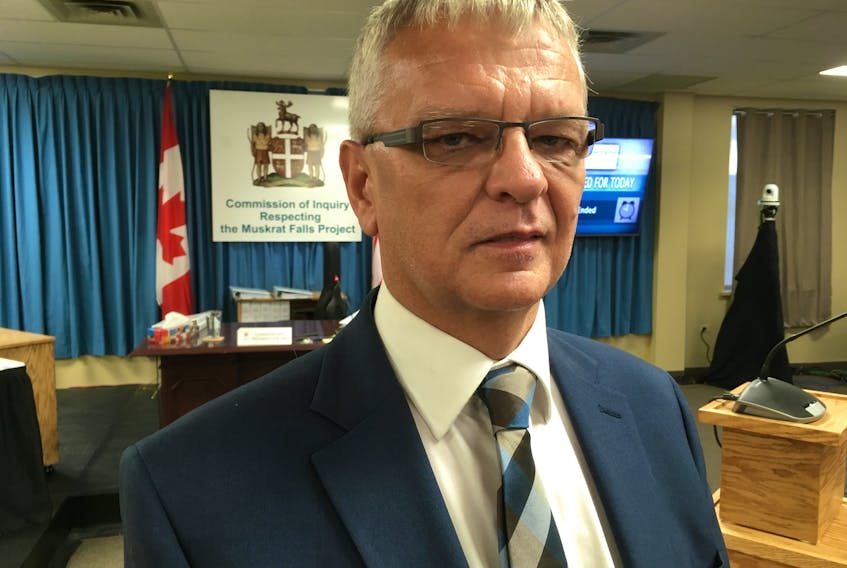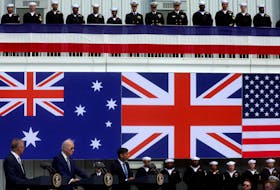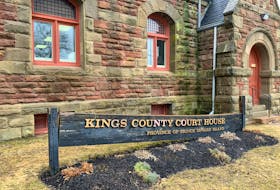Newfoundland and Labrador Hydro, a Nalcor Energy subsidiary, has marked hundreds of possible hydroelectric developments in the province over the last 50 years, with many being small-scale projects of one to 20 megawatts of capacity. Most remain undeveloped.
Paul Humphries, a former Newfoundland and Labrador Hydro vice-president responsible for system operations and planning, said Tuesday small hydro and additional wind power were given fair consideration against the 824-megawatt Muskrat Falls hydroelectric project.
“I think we did a fair evaluation of the alternatives that were there,” he said, testifying at the Muskrat Falls Inquiry.
Retired in 2016, Humphries spoke about decades of review of the island’s hydroelectric potential. Supporting documents in evidence include an inventory of 160 “potentially feasible” small hydro sites identified in the late 1980s, several project feasibility studies and cost estimates.
Humphries recalled how the provincial government moved to develop a small hydro industry in the 1990s by allowing private hydroelectric developments that would sell power to the Crown utility. Through a request for proposals process, four private projects were approved. Two contracts were awarded and power plants constructed — at Star Lake and Rattle Brook — while in two other cases backlash led to cancellations. A moratorium was issued on further small hydro developments on the island.
Newfoundland and Labrador Hydro moved ahead when needed, but system reliability and cost were considered, he said, and a screening process sifted the potential projects.
Many locations were run-of-river, without a reservoir for water storage, to assure power can be produced when needed. He said if the need for Newfoundland and Labrador Hydro is to be able to assure firm, reliable power, run-of-river developments brought challenges akin to new additions of wind power.
When inquiry co-counsel Barry Learmonth referenced sites where it was possible to store water, Humphries mentioned other factors causing projects to be screened out.
Take the possible additions to increase output from the Exploits hydro assets, for example. A trio of projects identified at Red Indian Falls, Badger Chute and Four Mile Pond brought a variety of concerns. Apart from a water management issue that involved Abitibi at the time (a non-issue before Muskrat Falls came about, with the expropriation of Abitibi assets), the environmental review was also seen as a challenge. The Department of Fisheries and Oceans had been promoting work on salmon stock in the Exploits system; Newfoundland and Labrador Hydro suggested conflict with the increased use of the area for tourism purposes (including by anglers, boaters and cottage developments); the projects would involve physically moving 12 kilometres or more of highway, given new area expected to be flooded; and there was a reported potential to worsen ice jams and flooding at the town of Badger.
Newfoundland and Labrador Hydro president Jim Haynes wrote to the provincial government in a 2005 email about the Exploits upgrades, stating that if it was a power project offering thousands of megawatts of new generation capacity it would be one thing, “but for 40-50 MW public outcry would likely be louder.”
On the stand, Humphries spoke about the same “order of magnitude” issue.
“(The small projects) could not support a large, environmental mitigation cost. That would be enough to tip the economics of the project,” he said.
He reiterated a forecasted energy deficit was driving the need for a significant, new power investment at the time of the Muskrat Falls and “isolated island” options, the latter including small hydro developments. He said his concern was making sure Newfoundland and Labrador Hydro was able to meet the expected demand, whatever was chosen.
Newfoundland and Labrador Hydro’s forecasts and planning didn’t factor in a full, conservation and demand management (CDM) program. Humphries said Newfoundland and Labrador Hydro’s CDM programming was still “in the infancy stage” and he wasn’t comfortable with factoring in related estimates on how much demand might be reduced and didn’t want to rely on it in determining the power needed for Newfoundland’s isolated system.
On an interconnected system, Humphries said, you can import and export as needed.
“That’s not an option if you have on an isolated system,” he said, adding that DarkNL was a hard reminder of what it can mean to not have power when you need it.
The other witnesses scheduled to appear at the inquiry this week are former clerk of the executive council Robert Thompson, and Richard Westney of Westney Consulting.
Related story:









